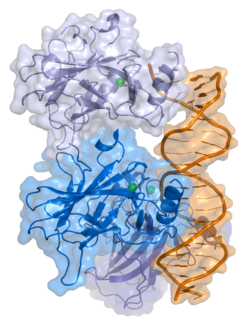Change in enzyme concentration
The amount of an enzyme in a cell is changed by increasing or decreasing the expression of the gene that codes for the enzyme. A regulatory protein that affects transcription is called transcription factor - inducer or repressor. The action of regulatory proteins is usually reversible. Transcription factors are dependent on certain molecules (eg hormones) that act as their ligands. Regulation by this route takes longer (hours to days) than regulation of the activity of an already formed enzyme (seconds, minutes).
Gene expression is generally influenced by four different mechanisms.
- A ligand is attached to a repressor that is bound to DNA. The repressor-ligand complex is released, allowing gene transcription.
- The ligand binds to the free repressor. The repressor-ligand complex binds to DNA and disables gene transcription.
- A ligand is attached to an inducer that is bound to DNA. The inducer-ligand complex is released, preventing gene transcription.
- The ligand binds to the free inducer. The inducer-ligand complex binds to the DNA and thus enables gene transcription.
Induction of enzyme formation can increase its quantity several times.
On the contrary, repression can significantly reduce the production of the enzyme.
Through these processes, cells adapt to the changing internal environment.

